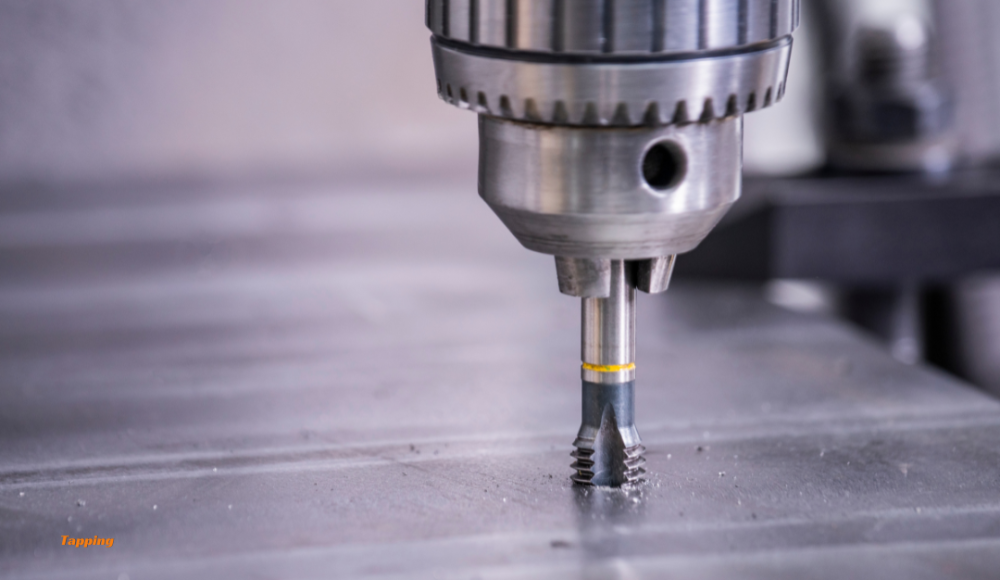Picture this: You’ve got a critical deadline looming, the perfect part in your hands, and all that’s left is creating those internal threads. But wait, should you tap or thread mill? The choice feels like a gamble with time and resources on the line.
Don’t sweat it – we’ll untangle the mystery of thread milling vs. tapping. Here’s the lowdown on what you’ll learn:
- The Basics:Get a quick rundown of tapping and thread milling.
- Pros and Cons:Uncover the strengths and weaknesses of each technique.
- Decision Time:Learn how to pick the right method for your project.
- Key Factors:We’ll arm you with what to consider before you start threading.
So let’s get started.
What Is Tapping?
Tapping is a time-tested technique for creating internal threads. Think of it like using a specialized screw to carve out a matching groove in your workpiece. A tap is a cylindrical cutting tool with spiral flutes that channel away material as it rotates. These flutes also help maintain lubrication and prevent overheating during the tapping process.
Tapping in action: A step-by-step breakdown
- Drilling the pilot hole:The first step is to create a pilot hole using a drill bit with a diameter slightly smaller than the desired final thread size. This pilot hole ensures the tap stays centered and cuts clean threads.
- Tapping it out:Secure the tap in your drill chuck and apply a lubricant or cutting oil to reduce friction and improve chip flow. Gently guide the tap straight into the pilot hole, applying light pressure as it begins to cut. It’s crucial to maintain a square alignment to prevent the tap from breaking.
- Back it out:Once you’ve reached the desired depth, reverse the tapping direction to break off any metal shavings and slowly back the tap out of the hole. Tapping often creates small metal chips that can get trapped in the threads. Reversing the tap helps clear these chips and prevents them from damaging the threads or dulling the cutting tool.
Tapping’s versatility: Tapping shines for its ability to create internal threads in a wide range of materials, from soft metals like aluminum to tougher steels. Also, different tap designs allow you to create various thread forms, like the common V-shaped threads or the more specialized square threads.
Tapping: The Pros and Cons
Let’s break down the good and the not-so-good of tapping:
Pros
- Speed demon:For the right applications, tapping can be incredibly fast, especially in smaller holes.
- Simple setup:Tapping requires minimal preparation and can be integrated easily into most machining setups.
- Wide range of thread sizes:You’ve got lots of options, as various tap sizes exist to create different thread diameters and pitches.
Cons:
- Tap breakage:Taps can be brittle, and breaking one inside a workpiece can be a real headache.
- Limited materials:Tapping gets tougher in hard materials like steel. You might need specialized (and more expensive) taps for optimal results.
- One tool per size:Need a different thread size? That means a completely new tap, eating up your tool inventory.
When Tapping Shines
Tapping is a great choice when you need quick, relatively inexpensive internal threads in softer materials, especially for smaller hole sizes.
What Is Thread Milling?
Think of thread milling as a sculptor for metal. Instead of a tap carving out threads in a single pass, a thread mill uses a small, rotating tool to gradually mill away material. This technique uses a specialized tool – a thread mill – that features a cutting profile matched to the desired thread shape.
Thread milling in motion: A visual walkthrough
- Drill that hole:Like tapping, you’ll start with a pilot hole. But the hole diameter for thread milling is usually slightly larger than when tapping.
- Helical magic:The thread mill spins at high speeds and is guided in a precise, spiraling path inside the hole, gradually “carving” the threads into the workpiece. This helical motion creates the thread profile along with the desired pitch.
- Software control:Thread milling requires CNC (computer numerical control) technology. Modern CNC machines handle the complex movements needed for smooth and accurate thread creation.
Thread milling’s flexibility: Not only does thread milling open up thread creation in tougher materials, but it also handles larger holes with ease. Plus, a single thread mill can create different thread sizes and pitches with just a change in programming.
Thread Milling: The Pros and Cons
Let’s weigh the strengths and weaknesses of thread milling:
Pros
- Material mastery:Thread milling is a champ when dealing with tough materials like hardened steel and even exotic alloys.
- Larger holes, no problem:Thread milling breezes through creating threads in larger diameter holes.
- One tool does it all:A single thread mill can tackle a range of thread sizes and pitches – just adjust the CNC program.
- Smooth finish:The gradual material removal process often results in cleaner, smoother threads than tapping.
Cons
- Higher cost:Thread milling usually involves more expensive tooling and requires a CNC machine.
- Slower setup:Programming and setup for thread milling typically take a little longer than the straightforward process of tapping.
- Chip control:Thread milling generates more metal chips than tapping, requiring good chip-management strategies.
When Thread Milling Is The Way
Thread milling is ideal for complex parts, hard materials, large-diameter threads, and when you need flexibility in the thread sizes you create.
When to Choose Which?
The tap vs. thread mill decision isn’t always clear-cut. Here’s a breakdown to help you make the right call:
Tap It If…
- Speed is crucial:You need to create threads quickly, especially in smaller holes and softer materials.
- Project is simple:You’re only dealing with standard thread sizes and common materials.
- Budget is a concern:You’re focused on keeping costs down.
Thread Mill It If…
- Precision is key:You need threads with exceptional accuracy, finish, and tight tolerances.
- Material is tough:You’re working with hardened steel, titanium, or other challenging materials.
- Larger holes are involved:Your project calls for internal threads in holes with larger diameters.
- Flexibility is a must:You need to produce a variety of thread sizes and pitches.
Factors to Consider
Here are a few more things to ponder when choosing between tapping and thread milling:
- Hole type:Is it a through-hole, or does it end blindly? Thread milling is preferred for blind holes.
- Part size:How big is the workpiece? Larger parts might be easier to manage with thread milling.
- Production volume:How many threaded parts do you need to make? Tapping usually wins out with high volumes.
- Skill and experience:Do you have the necessary setup and programming skills for thread milling?
Pro Tip: In many cases, a combination of tapping and thread milling might be the most efficient solution, allowing you to leverage the strengths of each.
Got Threads? You’ve Got Choices
You’ve conquered the basics of tapping and thread milling, and you’re ready to make those threaded masterpieces. Let’s recap the takeaways so you can tackle your projects like a seasoned pro:
- Taps are for speed:Simple setups and smaller holes in softer materials
- Thread Millers rule the tough stuff:Hardened materials and larger holes
- Flexibility is king:Thread mills give you room to change thread sizes easily
- There’s a tool for every job:Consider all the factors before you choose
Understanding the pros and cons of tapping and thread milling puts you in the driver’s seat. Whether you’re tapping a simple hole or thread milling the most complex part, the choice is in your hands. Contact us for more information.




